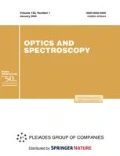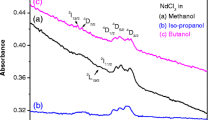Abstract
A systematic study of new photophysical and photochemical processes in solutions is continued by the example of a recently found phenomenon of redistribution of the intensities of two fluorescence bands of N,N′-Dimethylaminobenzonitrile (DMABN) in polar solutions at room temperatures under selective irradiation by light with different photon energies in the region of the long-wavelength absorption band. The effects observed are explained using data of quantum-mechanical calculations, which reveal that solutions of these systems are very likely to contain rotational isomers with different orientations of the dimethylamino group with respect to the plane of the benzonitrile residue. The excited-state charge transfer reactions in these rotamers occur in different ways and, hence, with different rates, because of which the intensity ratio of recorded fluorescence bands is different for different wavelengths of selective excitation. In this study, the influence of the temperature on the red-edge excitation effect observed in the fluorescence of DMABN solutions in acetonitrile is studied in the temperature range of 274–313 K using the previously used selective excitation method. It is found that these effects manifest themselves at any temperature within this range, but are especially strong at 313 K. The parameters of the dual fluorescence that are most sensitive for recording of the considered effects are determined, and the obtained temperature dependences are interpreted.
Similar content being viewed by others
References
Molecular Interactions, Ed. by H. Ratajczak and W. J. Ortwille-Thomas (Willey, New York, 1983), Vol. 2.
J. Lakowicz, Principles of Fluorescent Spectroscopy (Plenum, New York, 1984).
B. Valeur, Molecular Fluorescence. Principles and Applications, 4th ed. (Wiley-VCH, New York, 2007).
Z. R. Grabowsky, K. Rotkiewicz, and W. Rettig, Chem. Rev. 103, 3899 (2003).
A. P. Demchenko, Fundamental Photoprocesses and Inhomogeneous Broadening of Electronic Spectra of Organic Molecules, Ed. by V. I. Tomin (Wyd. PAP, Slupsk 2006), p. 79.
A. P. Demchenko, Introduction to Fluorescence Sensing (Springer-Verlag, Berlin, 2009).
C. C. Hsieh, M. L. Ho, and P. T. Chou, in Springer Series on Fluorescence, Methods and Applications. Advanced Fluorescence Reporters in Chemistry and Biology I. Fundamentals and Molecular Design, Ed. by A. Demchenko (Springer, New York, 2010), Vol. 8, p. 225.
E. Lippert, W. Luder, F. Moll, W. Nagele, H. Boos, H. Prigge, and I. Seibold-Blankenstein, Angew. Chem. 73, 695 (1961).
Z. R. Grabowski, K. Rotkiewicz, A. Siemiarczuk, D. J. Cowley, and W. Baumann, Nouv. J. Chim. 3, 2013 (1979).
U. Leinhos, W. Kuhle, and K. A. Zachariasse, J. Phys. Chem. 95, 2013 (1991).
K. A. Al-Hassan and W. Rettig, Chem. Phys. Lett. 126(3), 273 (1986).
D. Braun and W. Rettig, Chem. Phys. Lett. 268, 110 (1997).
V. I. Tomin and K. Hubisz, Opt. Spektrosk. 112(5), 769 (2012).
V. I. Tomin and K. Hubisz, Opt. Spektrosk. 110(5), 762 (2011).
N.G. Bakhshiev, Spectroscopy of Intermolecular Interactions (Nauka, Leningrad, 1972) [in Russian].
N. G. Bakhshiev, Photophysics of Dipole-Dipole Interactions: Solvation and Complexation Processes l (St. Petersburg Gos. Univ., St. Petersburg, 2005) [in Russian].
W. Demtröder, Laser spectroscopy. Basic concepts and instrumentation (Springer-Verlag, New York, 1988).
V. S. Antonov, G. I. Bekov, M. A. Bol’shov, V. P. Zharov, V. S. Letokhov, Yu. A. Kuritsyn, R. I. Personov, and A. N. Shibanov, Laser Analytical Spectroscopy (Nauka, Moscow, 1986) [in Russian].
V. I. Tomin, in Springer Series on Fluorescence, Methods and Applications. Advanced Fluorescence Reporters in Chemistry and Biology I. Fundamentals and Molecular Design, Ed. by A. Demchenko (Springer, Heidelberg, Dordrecht, London, N.Y., 2010), Vol. 8, p. 189.
A. N. Terenin Photonics of Molecules of Dyes and Related Organic Compounds (Nauka, Leningrad 1967) [in Russian].
B. I. Stepanov, Luminescence of Complex Molecules (Izd-vo AN BSSR, Minsk, 1955) [in Russian].
M. A. El’yashevich, Atomic and Molecular Spectroscopy (Fiz.-mat. Lit., Moscow, 1962) [in Russian].
W. Liptay, Z. Naturforsch., A: Phys. Sci. 20, 1441 (1965).
E. Lippert, in Organic Molecular Photophysics, Ed. by J. B. Birks (Wiley, London, 1975), p. 1.
W. C. Galley and R. M. Purkey, Proc. Natl. Acad. Sci. U.S.A. 67, 1167 (1970).
A. N. Rubinov and V. I. Tomin, Opt. Spektrosk. 29, 1082 (1970).
A. N. Rubinov and V. I. Tomin, Opt. Spektrosk. 32, 32 (1971).
G. Weber and M. Sinitsky, Proc. Natl. Acad. Sci. USA 65, 823 (1970).
A. Nemkovich, A. N. Rubinov, and V. I. Tomin, in Topics in Fluorescence Spectroscopy: Principles, Ed. by Ed. by J. R. Lakowicz (Plenum, New York, 1991), Vol. 2, p. 367.
A. P. Demchenko, J. Liminesc. 17, 19 (2002).
A. B. J. Parusel, Phys. Chem. Chem. Phys. 2, 5545 (2000).
D. Rappoport and F. Furche, J. Am. Chem. Soc. 126, 1277 (2004).
I. F. Galvan, M. E. Martin, and A. Aguilar, J. Chem. Theory Comp. 6, 2445 (2010).
I. G. Shere, V. P. Pawar, and S. C. Mehrotra, J. Mol. Liq. 133, 116 (2007).
M. A. Kahlow, T. J. Kang, and P. E. Barbara, Adv. Photo Chem. 15, 1 (1990).
A. S. R. Koti and N. Pieriasamy, Res. Chem. Intermediates 28, 831 (2002).
P. Changenet, P. Plaza, and Y. H. Meyer, J. Phys. Chem. A 101, 8186 (1997).
V. I. Tomin, in Hydrogen Bonding and Transfer in the Excited State, Ed. by Ke-Li-Han (Willey, New York, 2011), Vol. 2, p. 463.
V. I. Tomin, Opt. Spektrosk. 113(1), 35 (2012).
M. Brozis, K. A. Kozyra, V. I. Tomin, and Yu. Khel’dt, Zh. Prikl. Spektrosk. 69, 480 (2002).
V. I. Tomin and K. Hubisz, Opt. Spektrosk. 101(1), 104 (2006).
M. Jozefowicz, J. Fluoresc. 21, 239 (2011).
Author information
Authors and Affiliations
Corresponding author
Additional information
Original Russian Text © V.I. Tomin, A. Wlodarkiewicz, 2013, published in Optika i Spektroskopiya, 2013, Vol. 115, No. 1, pp. 98–107.
Rights and permissions
About this article
Cite this article
Tomin, V.I., Wlodarkiewicz, A. The influence of temperature on red-edge excitation effects in liquid solutions of N,N′-dimethylaminobenzonitrile. Opt. Spectrosc. 115, 86–93 (2013). https://doi.org/10.1134/S0030400X13050202
Received:
Published:
Issue Date:
DOI: https://doi.org/10.1134/S0030400X13050202




